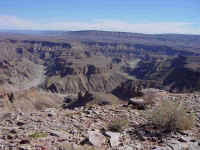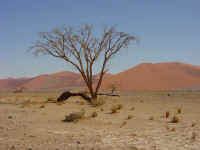|
A Tour of Southern Namibia
(For a fresh perspective on Namibia and an account of the last two weeks of our school holiday, we have enlisted Sera’s dad, Nelson, as a guest columnist for this e-mail.) Stana and I have been touring Namibia for just over two weeks. The best way to describe this place is a land of contrasting beauty. These very words are in the country’s national anthem. We have seen every type of geological formation except for swamplands, every color of sand imaginable and a wide variety of plants and animals. Namibia is totally different from anything we have ever experienced, save for the landscapes of southern Colorado and New Mexico. For seven days we traveled on a 1,400-mile tour through southern Namibia in which we camped and stayed in a “bush lodge” BRIEFLY during the nights, because from before dawn until after sunset we were usually climbing sand dunes, exploring canyons inside and out and touring the countryside in a 4X4 Land Cruiser converted to carry 10 people. We traveled with Chantel and Lucky (our two guides), a Californian, a British couple and a young lady from Germany. At the end of seven days, we were happy to abandon this exhausting vagabond lifestyle, but the safari was excellent in exposing us to many of the natural things that make Namibia a special place. Chantel and Lucky were marvelous at explaining how insects, plants and animals have adapted to surviving in Back in Windhoek (capitol city in center of country) after our safari, we rented an Opel Astre compact vehicle to embark on our own safari to the northern part of the country, where Sera and Zac live. Gas is about $2.13 a gallon, converting liters to gallons and Namibian dollars to US dollars. No one here seems to be complaining. The last two days were spent in Etosha National Park, an extremely large game park in the north, near Sera and Zac’s home and school. We spotted a male and female lion almost as soon as we entered the park. They were napping in the early morning sun less than 20 yards off the road. We saw giraffes and zebras everywhere, as well as the bouncy-gaited springboks (small antelopes), oryxes (larger antelopes), kudus (still larger antelopes), impalas, blue wildebeests, warthogs, hyenas, jackals and elephants grazing, sleeping, watching us and drinking at watering holes. An added extra was spotting two miniature Damara dik-diks, a deer that stands only as high as the seat of a chair. Quite often we sat in our rental car and watched the activity at watering holes for hours. We stayed at a “resort” rest camp in the center of the park. These resorts have tall electric fences to keep the toothy animals away from campers and lodgers, as well do the infrequent restroom areas staged inside the park. The park rules state that visitors must remain in their cars/safari vehicles at all times because of some of the ferocious beasts in the park. The park is so beautiful that we stayed inside its gates until the last possible minute of our allotted stay, sunrise Sunday until sunset Monday. At 5 p.m., the gates closed and we barely escaped by the skin of our teeth. Temperatures have been in the 80s during the day and 50s at night. In Swakopmund on the Atlantic coast during our southern tour, the temperature may have dropped to 45 degrees. After all, it is “November” here. And as is typical of autumn in Ohio, deciduous trees are changing to shades of yellows, browns and russets. The wild grasses are golden and a good mix of colors are swathed in bands and blotches across the savannahs like an artist’s brush strokes and spatters. School starts tomorrow and today the learners are arriving via taxi to study here for the next term. This week we will be observing activities at Sera and Zac’s school, visiting some indigenous homesteads, and traveling to two towns in the far north near the Angola border before we return our rental car in Windhoek where we plan to fly for home on Saturday. Driving through Namibia can be a challenge. Gas stations are positioned about every 100 miles and in between there is nothing – no billboards, no Dairy Marts, no 7-11s, no truck stops. Most safari vehicles carry two spares as the roadside thorns are treacherous on tires. We changed a tire during our southern tour and at one point we could hear air hissing out of a Land Rover “tyre,” as they call them here, at a resort parking lot.
-Nelson Click for more photos of Sossusvlei & Namib Desert | Fish River Canyon | Luderitz & Diaz Point | Kolmanskop & Klein Aus Mtns
|
 the harsh conditions of the desert. Chantel, a young Namibian woman in her mid-twenties, had no qualms about picking up desert bugs the size of large hair curlers with poisonous spurs on their legs and describing to us how they obtain water and survive. She also advised us to be aware of the plant life, most of which have spiny thorns and are poisonous, and warned us not to fall into such a plant. This experience opened our eyes to how very alive (and fragile) the desert can be. These guides seemed proud to show off their beautiful country to foreigners.
the harsh conditions of the desert. Chantel, a young Namibian woman in her mid-twenties, had no qualms about picking up desert bugs the size of large hair curlers with poisonous spurs on their legs and describing to us how they obtain water and survive. She also advised us to be aware of the plant life, most of which have spiny thorns and are poisonous, and warned us not to fall into such a plant. This experience opened our eyes to how very alive (and fragile) the desert can be. These guides seemed proud to show off their beautiful country to foreigners. The Namibian landscape changes – sometime abruptly and sometimes subtly – about every 20 miles. And for a photographer, there is a Kodak moment about every five feet. I have shot about 400 frames so far, including some video of animals. Yes, I even had to restrain myself to ration my camera memory chips. I am certain there is not enough film in existence to capture the exquisite beauty of Africa. When it comes time to leave this beautiful country, my imagination will still be wandering among the sand dunes, savannahs and veldts of this extraordinary place of magnificence and splendor.
The Namibian landscape changes – sometime abruptly and sometimes subtly – about every 20 miles. And for a photographer, there is a Kodak moment about every five feet. I have shot about 400 frames so far, including some video of animals. Yes, I even had to restrain myself to ration my camera memory chips. I am certain there is not enough film in existence to capture the exquisite beauty of Africa. When it comes time to leave this beautiful country, my imagination will still be wandering among the sand dunes, savannahs and veldts of this extraordinary place of magnificence and splendor.